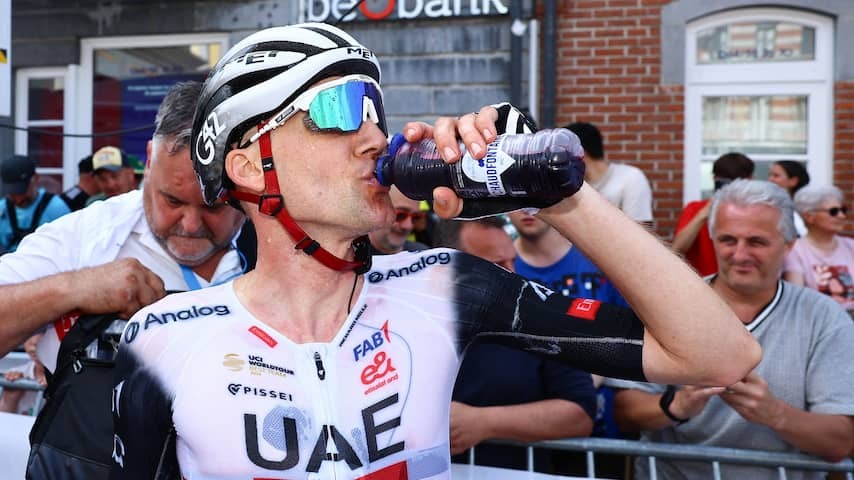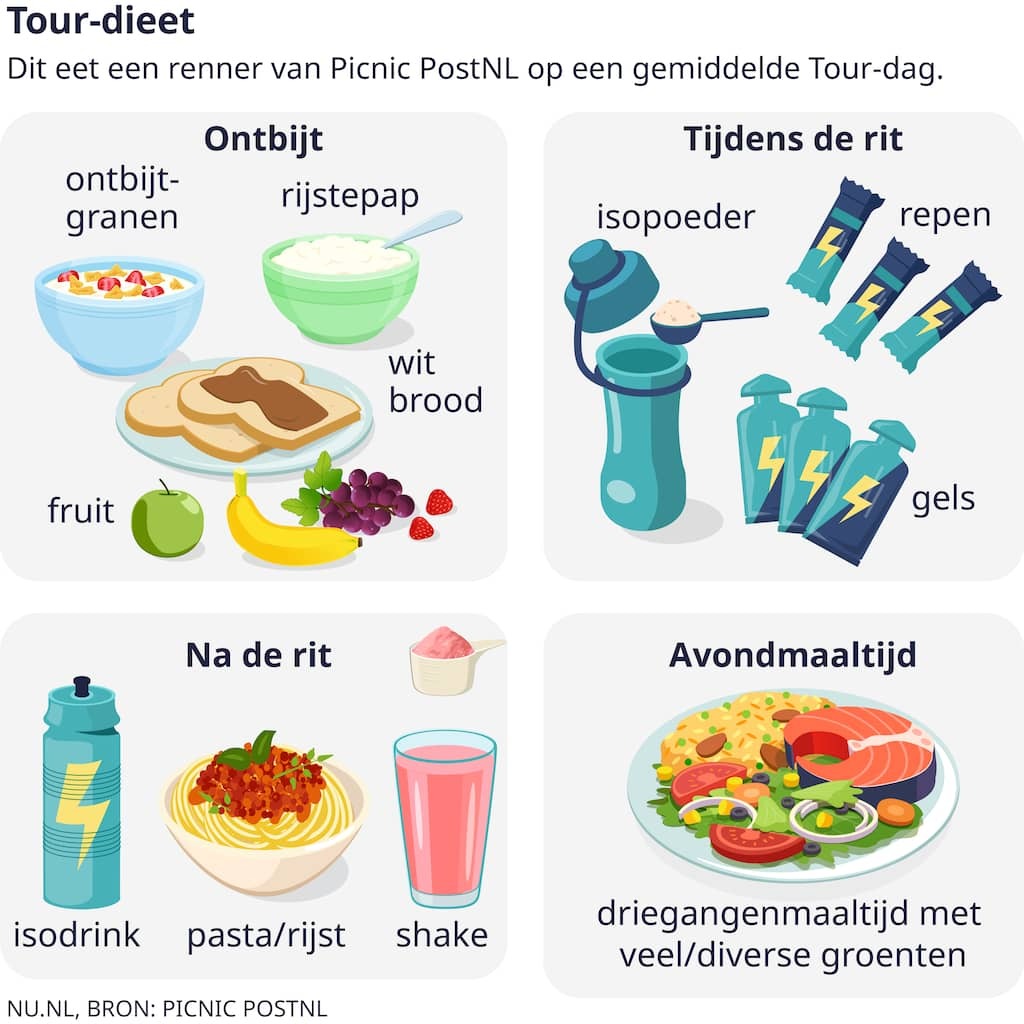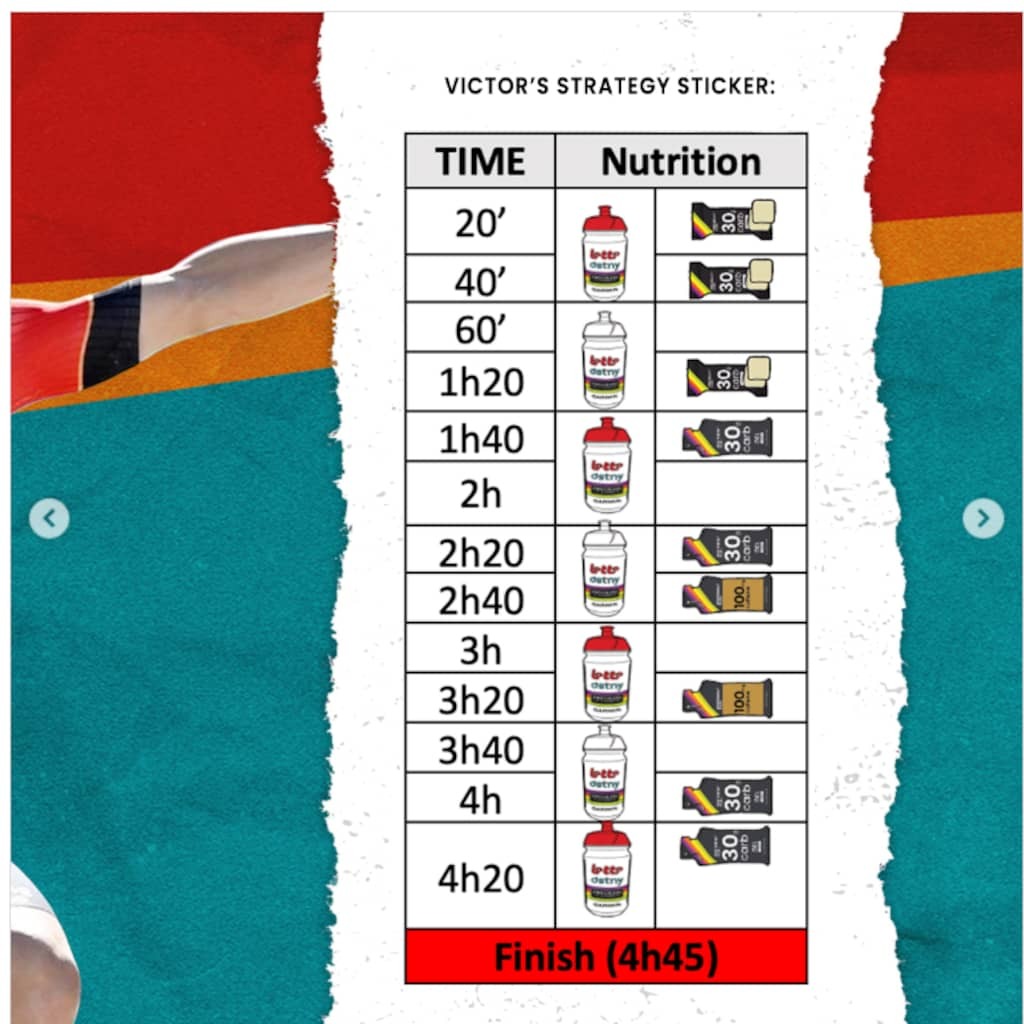
The biggest revolution in the Tour de France is in the stomach. Riders eat and drink twice as many sugars during stages as they used to. And that without extra intestinal problems. “Five years ago, I pooped my pants after a tough race.”
Tim Naberman was at the dentist a few weeks before his debut in the Tour de France for a cavity. “The dentist said: ‘Eating sugar isn’t that bad, but don’t do it often in a day’,” the 26-year-old Dutchman from Team Picnic PostNL tells NU.nl. “Then I had to explain that for my work, I consume 30 grams of sugars every fifteen minutes. And that for hours.”
Eating less sugar is not an option for a Tour rider like Naberman. To be able to cycle almost 200 kilometers every day for three weeks, a lot of energy is needed.
On an average day in the Tour de France, a rider consumes as much as 7,500 kilocalories. In tough stages, the counter even goes towards 10,000. That is four times the calorie requirement of an average man. The image below shows what a Picnic PostNL rider eats and drinks on a day in the Tour.

‘Amount of food is extraordinary’
“Compare it to 24 cheeseburgers in one day,” says Narelle Neumann, who, as head of science at Picnic PostNL, is very busy with nutrition. “That’s not what riders eat, of course. The fact remains that the amount of food and fluid they take in is extraordinary. We have to ensure that this intake is as efficient and healthy as possible.”
Cycling teams nowadays mainly look at eating and drinking during the race. Until about five years ago, teams – and their scientists – thought that riders could take in a maximum of 60 grams of carbohydrates per hour. Now, practically every Tour participant consumes at least 120 grams of sugars per hour.
“That is the most important change in cycling in recent years,” says Mathieu Heijboer, head of performance at the Dutch top team Visma-Lease a Bike. “It’s really a gamechanger.”
‘If I was hungry, I took a bar’
Heijboer remembers well how he dealt with nutrition as a professional rider at the beginning of this century. “I didn’t even get to 60 grams of carbohydrates per hour on the bike,” says the 43-year-old Dutchman. “It went on feeling. If I was hungry, I took a bar.”
Now Heijboer is in the management of a team that employs fifteen chefs and nutrition experts. “We were one of the first cycling teams to set up the entire organization to be able to reach 90 grams of carbohydrates per hour. Later that became 120 grams per hour. And now everyone is doing it.”
Thanks to Victor Campenaerts, a good picture has emerged of the sugar intake during a race. The then nutrition sponsor of the Belgian shared last year after his stage victory in the Tour de France how he took in about 2,200 kilocalories (or 130 grams of carbohydrates per hour) in just over four hours.
As can be seen in the image below, Campenaerts took three energy bars, four regular gels, two gels with caffeine and eight bottles containing carbohydrate powder (good for over 4 liters of fluid).

‘Cycling has become a lot more pleasant’
The direct result of the better race fueling can be seen again in this Tour. People are riding hard and long solos are becoming more common. For example, Ben Healy won the sixth stage on Thursday after riding the last 42.5 kilometers alone. Riders can sustain a major effort longer and better.
“I come from a time when we weren’t allowed to eat too much, especially during training,” says Heijboer. “As a result, we were hungry on the bike. And at the end of the day you went to compensate a lot.”
That compensation behavior is now almost no longer necessary. By eating more while cycling, riders recover faster and feel better. “The sport has become much healthier due to the carbohydrate revolution,” said 32-year-old Visma rider Simon Yates earlier this year to Velo. “I enjoy cycling much more now than seven years ago. Then I was completely broken all the time.”
Generation mate Mike Teunissen recognizes himself in the words of the Giro d’Italia winner. “I’m not completely messed up after a training or competition anymore,” says the Astana rider. “I have been less in my reserves and therefore recover relatively easier. That makes cycling a lot more pleasant.”
New nutrition ensures fewer intestinal problems
Everyone understands that eating a lot can also have unpleasant consequences. Stomach and intestinal problems are lurking. “Five years ago I always pooped my pants after tough races,” said three-time Tour winner Tadej Pogacar last year in a podcast with doctor Peter Attia. “120 grams of carbohydrates per hour was really impossible then. Now I no longer have stomach problems.”
One explanation is training and habituation. But the most important reasons are the better products that are now available at practically all teams. This mainly concerns gels and energy bars containing a lot of sugars.
“I still wouldn’t recommend an amateur rider to eat 120 grams of carbohydrates per hour. Because then you will be sitting on the toilet for a while,” says Picnic PostNL rider Naberman. “But if you are used to it – like us – then the chance of problems with this new stuff is very small.” Laughing: “But unfortunately these products cannot prevent cavities.”